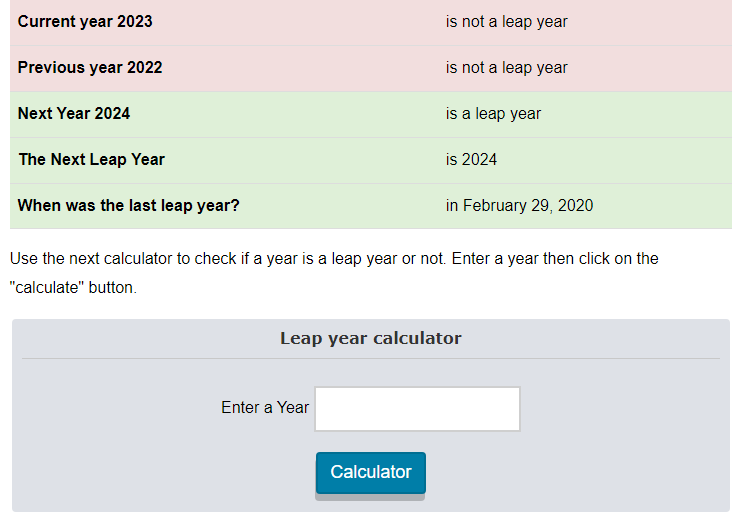Navigating The Leap: Determining The Number Of Leap Years From 2013 To 2025
Navigating the Leap: Determining the Number of Leap Years from 2013 to 2025
Navigating the Leap: Determining the Number of Leap Years from 2013 to 2025
Introduction
With great pleasure, we will explore the intriguing topic related to Navigating the Leap: Determining the Number of Leap Years from 2013 to 2025. Let’s weave interesting information and offer fresh perspectives to the readers.
Table of Content
Navigating the Leap: Determining the Number of Leap Years from 2013 to 2025

The concept of a leap year, with its extra day in February, is a cornerstone of our calendar system, ensuring that the solar year and the calendar year remain synchronized. This synchronization is vital for numerous aspects of our lives, from agricultural practices to astronomical observations. Determining the number of leap years within a specific period, such as from 2013 to 2025, requires a clear understanding of the rules governing leap years.
Understanding the Leap Year Rules
The foundation of the leap year system lies in the fact that the Earth takes approximately 365.2422 days to complete one orbit around the sun. To account for this extra quarter of a day, we add an extra day to February every four years. However, this simple rule needs refinement to ensure accuracy.
Here are the key rules governing leap years:
-
Divisible by Four: A year is a leap year if it is divisible by four. This captures the basic principle of adding an extra day every four years.
-
Divisible by One Hundred: A year divisible by 100 is not a leap year, unless it is also divisible by 400. This exception addresses the slight overestimation of the solar year by the basic rule.
-
Divisible by Four Hundred: A year divisible by 400 is a leap year, regardless of whether it is divisible by 100. This exception ensures that the calendar remains in sync with the solar year over the long term.
Applying the Rules to 2013-2025
Let’s apply these rules to determine the number of leap years between 2013 and 2025. We need to examine each year within this range and see if it meets the leap year criteria:
- 2013: Not divisible by 4, therefore not a leap year.
- 2014: Divisible by 4, therefore a leap year.
- 2015: Not divisible by 4, therefore not a leap year.
- 2016: Divisible by 4, therefore a leap year.
- 2017: Not divisible by 4, therefore not a leap year.
- 2018: Divisible by 4, therefore a leap year.
- 2019: Not divisible by 4, therefore not a leap year.
- 2020: Divisible by 4, therefore a leap year.
- 2021: Not divisible by 4, therefore not a leap year.
- 2022: Not divisible by 4, therefore not a leap year.
- 2023: Not divisible by 4, therefore not a leap year.
- 2024: Divisible by 4, therefore a leap year.
- 2025: Not divisible by 4, therefore not a leap year.
Therefore, there are five leap years between 2013 and 2025: 2014, 2016, 2018, 2020, and 2024.
The Significance of Leap Years
The inclusion of leap years is crucial for maintaining the accuracy of our calendar system. It ensures that the seasons remain aligned with the calendar year, preventing significant discrepancies over time. This alignment is vital for:
- Agriculture: Farmers rely on the calendar to plan planting and harvesting schedules. Accurate calendar dates ensure that crops are sown and harvested at the optimal time for maximum yield.
- Astronomy: Astronomical observations and calculations depend on the precise timing of celestial events. A synchronized calendar allows for accurate predictions of eclipses, equinoxes, and other celestial phenomena.
- Cultural Celebrations: Many cultural and religious celebrations are tied to specific dates on the calendar. Leap years ensure that these events remain aligned with the natural cycle of seasons.
Frequently Asked Questions (FAQs)
Q: Why are leap years important?
A: Leap years are essential for maintaining the synchronization between the solar year and the calendar year. Without them, the calendar would drift out of alignment with the seasons, leading to inaccuracies in agricultural practices, astronomical observations, and cultural celebrations.
Q: Why do we add an extra day to February?
A: February is chosen as the month for the extra day because it is the shortest month in the calendar. Adding a day to February minimizes the disruption to the overall calendar structure.
Q: Can a leap year be skipped?
A: No, leap years cannot be skipped. The rules governing leap years are designed to ensure that the calendar remains in sync with the solar year. Skipping a leap year would create a significant discrepancy between the calendar and the actual length of the solar year.
Tips for Remembering Leap Years:
- Divisibility by Four: A simple rule of thumb is to remember that any year divisible by four is a leap year.
- Exceptions: Keep in mind the exceptions for years divisible by 100 and 400. These exceptions are crucial for ensuring accuracy over long periods.
- Calendar Resources: Use online calendar resources or almanacs to verify whether a specific year is a leap year.
Conclusion
The inclusion of leap years is a testament to the ingenuity of our calendar system. By incorporating this seemingly simple adjustment, we ensure that our calendar remains aligned with the natural cycle of the Earth’s orbit around the sun. This synchronization is vital for maintaining accuracy in various aspects of our lives, from agriculture and astronomy to cultural celebrations. Understanding the rules governing leap years allows us to navigate the complexities of our calendar system and appreciate its vital role in our daily lives.








Closure
Thus, we hope this article has provided valuable insights into Navigating the Leap: Determining the Number of Leap Years from 2013 to 2025. We appreciate your attention to our article. See you in our next article!